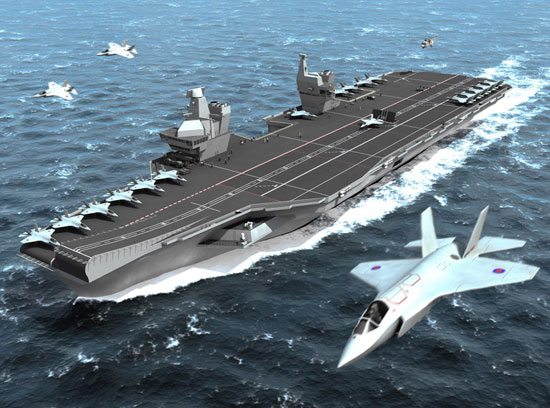Construction of the first of the two new aircraft carriers for the Royal Navy, HMS Queen Elizabeth, took a huge step forward today as workers at BAE Systems’ Govan yard moved two giant sections of the hull together for the first time.
The structure is so big that it fills an entire hall at Govan and now extends beyond the doors onto the yard, providing a spectacular view from across the River Clyde.
Highlighting the skill and technology involved in British shipbuilding today, it took a team of 20 employees and remote controlled transporters just one hour to move 1,221 tonnes of steel over 100 metres across the shipyard. The hull section was then manoeuvred carefully into position to line up with the rest of the block.
Steven Carroll, Queen Elizabeth Class Project Director at BAE Systems’ Surface Ships division, said: “Seeing the mid section of the carrier come together brings into sharp focus the sheer scale and complexity of this engineering feat.
“With construction underway at six shipyards across the country, it is one of the biggest engineering projects in the UK today – second only to the London 2012 Olympics – and we’re all very proud to be a part of it.”
The two sections brought together today form the mid section of the hull up to the hangar deck and is referred to as Lower Block 03. Workers will now continue to outfit the block, which on completion will weigh over 9,300 tonnes and stand over 23 metres tall, 63 metres long and 40 metres wide. She is set to embark on the next stage of her journey to Rosyth in the latter part of this year, where HMS Queen Elizabeth will be assembled in the dry dock.
As a member of the Aircraft Carrier Alliance, BAE Systems is working in partnership with Babcock, Thales and the Ministry of Defence to deliver the nation’s flagships. This huge massive engineering project is rapidly gaining momentum and employs over 8,000 people across shipyards in Glasgow, Portsmouth, Appledore, Rosyth, Merseyside and Newcastle, with thousands more across the supply chain.
BAE Systems is also constructing the main stern section at its yard on the Clyde, which is the largest and most complex section of the carrier. At its Portsmouth facilities, work is well underway to construct the forward and lower stern sections of the hull, as well as the pole mast, whilst integration and testing of the ships’ complex mission system is underway at the Company’s Maritime Integration and Support Centre. Another team of BAE Systems engineers on the Isle of Wight is testing the advanced communication systems. The Company is set to begin work on the two island structures, which house the bridge and traffic control facilities, towards the end of the year.
Each 65,000 tonne carrier will provide the armed forces with a four acre military operating base which can be deployed worldwide. The vessels will be versatile enough to be used for operations ranging from supporting war efforts to providing humanitarian aid and disaster relief.
[table id=25 /]










